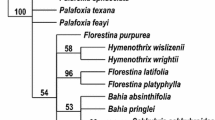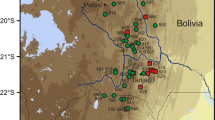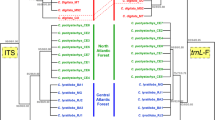Abstract
Campomanesia comprises approximately 45 species, and 18 of them are organized into three informal morphological complexes. Among these, the “C. xanthocarpa complex” includes nine accepted species displaying delimitation problems, especially in C. adamantium (Cambess.) O.Berg, C. eugenioides (Cambes.) D.Legrand ex Landrum and C. xanthocarpa (Mart.) O.Berg. As there are no phylogenies available for the genus, we seek to understand whether the morphological similarities observed between the cited taxa may be congruent with molecular data. Thus, we generated sequences of the internal transcribed spacer of the ribosomal nuclear DNA (ITS) from 32 samples of Campomanesia and nine belonging to other genera of neotropical Myrtaceae. Phylogenetic analyses using Maximum Parsimony and Bayesian Inference produced similar topologies, which indicate that the “C. xanthocarpa complex” is not monophyletic. Otherwise, the taxa previously assigned to this complex correspond to two distinct lineages highly supported, here designated as the “C. xanthocarpa Group” and “C. eugenioides Group.” The use of multiple accessions of these species also provided taxonomic insights for the recognition of C. littoralis D.Legand and C. repanda O.Berg, as well as the separation of C. rhombea from C. xanthocarpa.



Similar content being viewed by others
References
Alfaro M, Zoller S, Lutzoni F (2003) Bayes or Bootstrap? A simulation study comparing the performance of Bayesian Markov chain Monte Carlo sampling and bootstrapping in assessing phylogenetic confidence. Mol Biol Evol 20:255–266
Alvarez A, Wendel JF (2003) Ribosomal ITS sequences and plant phylogenetic inference. Mol Phylogenet Evol 29:417–434
Amaral EVEJ, Sales JF, Reis EF, Coelho CP, Castro EM, Pinto JFN (2020) Campomanesia adamantium and Campomanesia pubescens are distinct species? Use of palynology and molecular markers in taxonomy. Rodriguésia 71:e02652018. https://doi.org/10.1590/2175-7860202071132
Amorim BS, Vasconcelos TNC, Souza G, Alves M, Antonelli A, Lucas E (2019) Advanced understanding of phylogenetic relationships, morphological evolution and biogeographic history of the mega-diverse plant genus Myrcia and its relatives (Myrtaceae: Myrteae). Mol Phylogenet Evol 138:65–88
Bailey CD, Carr TG, Harris SA, Hughes CE (2003) Characterization of angiosperm nrDNA polymorphism, paralogy, and pseudogenes. Mol Phylogenet Evol 29:435–455
Baldwin BG, Sanderson MJ, Porter JM, Wojciechowski MF, Campbell CS, Donoghue MJ (1995) The ITS region of nuclear ribosomal DNA: a valuable source of evidence on angiosperm phylogeny. Ann Mo Bot Gard 8:247–277
Bayly MJ, Udovicic F, Gibbs AK, Parra-O C, Ladiges P (2008) Ribosomal DNA pseudogenes are widespread in the eucalypt group (Myrtaceae): implications for phylogenetic analysis. Cladistics 24:131–146
Berg O (1855–1856) Revisio Myrtacerum Americae. Linnaea 27:1–472
Berg O (1857–1859) Myrtaceae. In: Martius, C.F.P. von. Fl. bras. 14:430–465
Biffin E, Lucas EJ, Craven LA, Costa IR, Harrington MG, Crisp M (2010) Evolution of exceptional species richness among lineages of fleshy-fruited Myrtaceae. Ann Bot 106:79–93
Bucker ES IV, Ippolito A, Holtsford TP (1997) The evolution of ribosomal DNA: divergent paralogues and phylogenetic implications. Genetics 145:821–832
Cardoso D, de Queiroz LP, Lima HC, Suganuma E, van den Berg C, Lavin M (2013) A molecular phylogeny of the vataireoid legumes underscores floral evolvability that is general to many early-branching papilionoid lineages. Am J Bot 100:403–421
Carrara MR (1997) Estudo das espécies de Campomanesia Ruiz & Pav. (Myrtaceae, Myrtinae) ocorrentes no estado do Rio de Janeiro. Masters dissertation, UFRJ/Museu Nacional, Rio de Janeiro
Chase MW, De Bruijn AY, Cox AV, Reeves G, Rudall PJ, Johnson MAT, Eguiarte LE (2000) Phylogenetics of Asphodelaceae (Asparagales): an analysis of plastid rbcL and trnL-F DNA sequences. Ann Bot 86:35–951
Costa IR (2009) Estudos evolutivos em Myrtaceae: aspectos citotaxonômicos e filogenéticos em Myrteae, enfatizando Psidium e gêneros relacionados. Thesis, Instituto de Biologia, Universidade Estadual de Campinas, São Paulo
Cruz F, Turchetto-Zoleti AC, Veto N, Mondin CA, Sobral M, Almerão M, Margis R (2013) Phylogenetic analysis of the genus Hexachlamys (Myrtaceae) based on plastid and nuclear DNA sequences and their taxonomic implications. Bot J Linn Soc 172:532–543
Doyle JJ, Doyle JL (1987) A rapid DNA isolation method for small quantities of fresh tissues. Phytochem Bull Bot Soc Am 19:11–15
Duminil J, Di Michele M (2009) Plant species delimitation: a comparison of morphological and molecular markers. Plant Biosyst 143:528–542
Edgar RC (2004) MUSCLE; multiple sequence alignment with high accuracy and high throughput. Nucleic Acids Res 32:1792–1797
Ferreira SC (2010) Filogenia molecular da subtribo Gyptidinae R.M.King & H.Rob. (Eupatorieae, Asteraceae) e revisão taxonômica do gênero Lasiolaena R.M.King & H.Rob. Thesis, Universidade Estadual de Feira de Santana, Bahia
Fitch WM (1971) Towards defining the course of evolution: minimum change for a specific tree topology. Syst Zool 20:406–416
Giaretta A, Amorim BS, Sano PT, Souza G, Lucas E (2019) Phylogenetic placement of new species with fused calyx reveals homoplastic character in Eugenia (Myrtaceae). Syst Bot 44:66–73
Govaerts R, Sobral M, Ashton P, Barrie F, Holst BK, Landrum LR, Matsumoto K, Mazine FF, Nic Lughadha E, Proença CEB, Silva LHS, Wilson PG, Lucas EJ (2021) World Checklist of Myrtaceae. Facilitade by the Royal Botanic Gardens, Kew. http://apps.kew.org/wcsp/home.do. Accessed 19 Mar 2021
Heywood VH, Brummitt RK, Culham A, Seberg O (2007) Flowering plant pamilies of the world. Firefly Books, New York
Huelsenbeck JP, Ronquist F, Nielsen R, Bollback JP (2001) Bayesian Inference of phylogeny and its impact on evolutionary biology. Science 294:2310–2314
Jonhson LAS, Briggs BG (1984) Myrtales and Myrtaceae-a phylogenetic analysis. Ann Missouri Bot Gard 71:700–756
Kawasaki ML (2000) A new species of Campomanesia (Myrtaceae) from southeastern Brazil. Brittonia 52:188–190
Landim MF, Landrum LR (2002) The genus Campomanesia (Myrtaceae) in Atlantic Rainforest fragments in Sergipe. Northeast Region of Brazil Sida 20:205–214
Landrum LR (1986) Campomanesia, Pimenta, Blepharocalyx, Legrandia, Acca, Myrrhinium and Luma (Myrtaceae). Fl Neotrop Monogr 45:7–72
Landrum LR, Stevenson D (1986) Variability of embryos in subtribe Myrtinae (Myrtaceae). Syst Bot 11:155–162
Landrum LR (1987) A new species of Campomanesia (Myrtaceae) from Brazil. Brittonia 39:245–247
Landrum LR, Kawasaki ML (1997) The genera of Myrtaceae in Brazil: an illustrated synoptic treatment and identification keys. Brittonia 49:508–536
Landrum LR (2002) Two new species of Campomanesia (Myrtaceae) from Espírito Santo and Bahia, Brazil. Brittonia 53:534–538
Landrum LR, Oliveira MIU (2010) A new species of Campomanesia (Myrtaceae) from Bahia, Brazil, based on specimens collected by J.S. Blanchet over 150 years ago. J Bot Res Inst Tex 4:603–607
Legrand CD Klein RM (1977) Mirtáceas–Campomanesia, Feijoa, Britoa, Myrrhinium, Hexaclamys, Siphoneugena, Myrcianthes, Neomitranthes e Psidium. Fl. Ilustr. Catarin., Parte I, As plantas, fasc. Mirt. CNPq/IBDF/HBR: Itajaí, São Paulo
Lima DF, Sobral GR, M, (2011) O gênero Campomanesia (Myrtaceae) no estado do Paraná. Rodriguésia 62:683–693
Lima, DF, Goldenberg, R, Forest F, Cowan RS, Lucas, EJ (2021) Phylogeny and biogeography of Myrcia sect. Aguava (Myrtaceae, Myrteae) based on phylogenomic and Sanger data provide evidence for a Cerrado origin and geographically structured clades. Mol Phylogenet Evol 157: 107043. https://doi.org/10.1016/j.ympev.2020.107043
Luber J, Oliveira MIL, Ferreira MFS, Carrijo TT (2017) Flora do Espírito Santo: Campomanesia (Myrtaceae). Rodriguésia 68:1767–1790
Luber J, Christ JA, Ferreira MF, Carrijo TT (2020) Species delimitation within Campomanesia (Myrtaceae) using morphology and amplification profiles of microsatellite markers. Braz J Bot 43:131–137
Lucas EJ, Belsham SR, Nic Lughadha EM, Orlovich DA, Sakuragui CM, Chase MW, Wilson PG (2005) Phylogenetic patterns in the fleshy-fruited Myrtaceae-preliminary molecular evidence. Pl Syst Evol 251:35–51
Lucas EJ, Harris SA, Belsham MFF, SR, Nic Lughadha EM, Telford A, Gasson PE, Chase MW, (2007) Suprageneric phylogenetics of Myrteae, the generically richest tribe in Myrtaceae (Myrtales). Taxon 56:1105–1128
Lucas EJ, Matsumoto K, Harris SA, Nic Lughadha EM, Benardini B, Chase MW (2011) Phylogenetics, morphology, and evolution of the large genus Myrcia s.l. (Myrtaceae). Int J Pl Sci 172:915–934
Lucas EJ, Holst B, Sobral M, Mazine FF, Nic Lughadha EM, Proença CEB, Costa IR, Vasconcelos TNC (2019) A new subtribal classification of Tribe Myrteae (Myrtaceae). Syst Bot 44:560–569
Machado LO, Vieira LN, Stefenon VM, Faoro H, Pedrosa FO, Guerra MP, Nodari RO (2020) Molecular relationships of Campomanesia xanthocarpa within Myrtaceae based on the complete plastome sequence and on the plastid ycf2 gene. Genet Mol Biol 43:1–14
Mazine-Capelo FF, Faria JEQ, Giaretta A., Vasconcelos T, Forest F, Lucas E (2018) Phylogeny and biogeography of the hyper-diverse genus Eugenia (Myrtaceae: Myrteae), with emphasis on E. sect. Umbellatae, the most unmoanageable clade. Taxon 67:752–769
Maddison WP Maddison DR (2011) Mesquite: a modular system for evolutionary analysis, v.2.75. http://mesquiteproject.org/. Accessed 21 July 2020
McVaugh R (1968) The genera of American Myrtaceae–an interim report. Taxon 17:354–418
Monteiro SHN, Selbach-Schnadelbach A, Oliveira RP, van den Berg C (2010) Molecular Phylogenetics of Galeandra (Orchidaceae: Catasetinae) based on Plastid and Nuclear DNA Sequences. Syst Bot 35:476–486
Murillo-Aldana J, Ruiz E (2011) Revalidation of Nothomyrcia (Myrtaceae) an endemic genus from Juan Fernandez Archipelago. Guyana Bot 68:129–134
Murillo-Aldana J, Ruiz E, Landrum L, Stuessy TF, Barfuss MHJ (2011) Phylogenetic relationships in Myrceugenia (Myrtaceae) based on plastid and nuclear DNA sequences. Mol Phylogenet Evol 62:764–776
Oliveira MIU, Funch LS, Landrum LR (2012) Flora da Bahia: Campomanesia (Myrtaceae). Sitientibus Sér Ci Biol 12:91–107
Oliveira MIU, Landrum LR, Oliveira RP, Funch LS (2013) A new species of Campomanesia (Myrtaceae) from Bahia, Brazil, and its relationships with the C. xanthocarpa complex. Phytotaxa 149:19–26
Oliveira MIU, Rebouças DA, Leite KRB, Oliveira RP, Funch LS (2018) Can leaf morphology and anatomy contribute to species delimitation? A case in the Campomanesia xanthocarpa complex (Myrtaceae). Flora 249:111–123
Oliveira, MIU, Costa, IR, Proença, CEB (2020) Campomanesia in Flora do Brasil 2020. Jardim Botânico do Rio de Janeiro. http://floradobrasil.jbrj.gov.br/reflora/floradobrasil/FB10307. Accessed 19 Mar 2021
Niedenzu F (1898). Myrtaceae. In: Prantl K, Engler A (eds) Nat Pflanzenfam 3:57–105
Nylander JAA (2008) MrModeltest v.2.3. Program distributed by the author. Evolutionary Biology Centre, Uppsala University
Paul N, Shum J, Le T (2010) Hot start PCR. Methods Mol Biol 630:301–318
Pinheiro F, Dantas-Queiroz MV, Palma-Silva C (2018) Plant species complexes as models to understand speciation and evolution: a review of South American studies. Crit Rev Plant Sci 37:54–80
Proença CEB, Soares-Silva LH, Silva PIT, Fank-de-Carvalho SM (2010) Two new endemic species of Myrtaceae and an anatomical novelty from the Highlands of Brazil. Kew Bull 65:463–468
Proença CEB, Jennings LVS, Lucas EJ (2011) Two new species of Myrtaceae (Myrteae) from northern South America. Brittonia 63:46–50
Rambaut A, Drummond AJ (2009) Tracer v.1.5. http://tree.bio.ed.ac.uk/software/tracer/. Accessed 21 July 2020
Rambaut A (2012) FigTree v.1.4. http://tree.bio.ed.ac.uk/software/figtree/. Accessed 21 July 2020
Rapini A, Ribeiro PL, Lambert S, Pirani JR (2008) A flora dos campos rupestres da Cadeia do Espinhaço. Megadiversidade 4:16–24
Ribeiro PL, Rapini A, Silva UCS, van den Berg C (2012) Using multiple analytical methods to improve phylogenetic hypotheses in Minaria (Apocynaceae). Mol Phylogenet Evol 65:915–925
Ronquist F, Teslenko M, van der Mark P, Ayres DL, Darling A, Höhna S, Larget B, Liu L, Suchard MA, Huelsenbeck JP (2012) MrBayes 3.2: efficient bayesian phylogenetic inference and model choice across a large model space. Syst Biol 61:539–542
Ruiz H Pavón J (1794) Florae Peruvianae et Chilensis Prodromus. (La Imprenta de Sancha: Madrid)
Salywon AM (2003) A monograph of Mosiera (Myrtaceae). Arizona State University, Thesis
Snow N, McFadden J, Evans TM, Salywon AM, Wojciechowski MF, Wilson P (2011) Morphological and molecular evidence of polyphyly in Rhodomyrtus (Myrtaceae: Myrteae). Syst Bot 36:390–404
Sobral M (2003) A família Myrtaceae no Rio Grande do Sul. Editora Unisinos, São Leopoldo
Staden R, Beal KF, Bonfield JK (1998) The Staden package. Methods Mol Biol 132:115–130
Sun Y, Skinner DZ, Liang GH, Hulbert SH (1994) Phylogenetic analysis of Sorghum and related taxa using internal transcribed spacers of nuclear ribosomal DNA. Theor Appl Genet 89:26–32
Swofford DL (2000) PAUP* v.4.0b10a: Phylogenetic Analysis Using Parsimony (*and other methods). Sinauer Associates Inc, Sunderland
Udovicic F, Ladiges PY (2000) Informativeness of nuclear and chloroplast DNA regions and the phylogeny of the eucalypts and related genera (Myrtaceae). Kew Bull 55:633–645
Vasconcelos TNC, Proença CEB, Ahmad B, Aguilar DS, Aguilar R, Amorim BS, Campbell K, Costa IR, De-Carvalho OS, Faria JEQ, Giaretta A, Kooij PW, Lima DF, Mazine FF, Peguero B, Prenner G, Santos MF, Soewarto J, Wingler A, Lucas EJ (2017) Myrteae phylogeny, calibration, biogeography and diversification patterns: Increased understanding in the most species rich of Myrtaceae. Mol Phylogenet Evol 109:113–137
Wilson PG, O’Brien MM, Heslewood MM, Quinn CJ (2005) Relationships within Myrtaceae sensu lato based on a matk phylogeny. Pl Syst Evol 251:3–19
Wilson PG (2011) Myrtaceae. In: Kubitzki K (ed) The families and genera of vascular plants - Sapindales, Cucurbitales, Myrtaceae, vol 10. Springer, Berlin, pp 212–271
White TJ, Bruns T, Lee S, Taylor J (1990) Amplification and direct sequencing of fungal ribosomal RNA genes for phylogenetics. In: Innis MA, Gelfand DH, Sninsky JJ, White TJ (eds) PCR Protocols: a guide to methods and applications. Academic Press, New York, pp 315–322
Acknowledgements
We thank Leslie Landrum and Élvia Rodrigues for their opinions; Jair Faria, Daniel Villarroel, Eloína Matos and Robson Avi who kindly collected samples of Campomanesia used in this study; CAPES (Coordenação de Aperfeiçoamento de Pessoal de Nível Superior) and CNPq (Conselho Nacional de Desenvolvimento Científico e Tecnológico, process 142180/2009-2) for doctoral scholarships granted; PRONEX/Fapesb/CNPq (Programa de Apoio aos Núcleos de Excelência/Fundação de Amparo à Pesquisa do Estado da Bahia/Conselho Nacional de Desenvolvimento Científico e Tecnológico, process PNX0014-2009); and PPBio-Semiárido (Programa de Pesquisa em Biodiversidade do Semiárido, process 558317/2009-0 and 457427/2012-4) for financial support. We also thank the CNPq by fellowships given to CVDB and RPO (PQ1A and PQ1C, respectively).
Funding
The first author received doctoral scholarships grants from CAPES (Coordenação de Aperfeiçoamento de Pessoal de Nível Superior) and CNPq (Conselho Nacional de Desenvolvimento Científico e Tecnológico, process 142180/2009-2). This work was supported by PRONEX/Fapesb/CNPq (Programa de Apoio aos Núcleos de Excelência/Fundação de Amparo à Pesquisa do Estado da Bahia/Conselho Nacional de Desenvolvimento Científico e Tecnológico, process PNX0014-2009) and PPBio-Semiárido (Programa de Pesquisa em Biodiversidade do Semiárido, process 558317/2009-0 and 457427/2012-4).
Author information
Authors and Affiliations
Contributions
MIUO, RPO and LSF contributed to the study’s conception and design. CVB contributed to the study design. Material preparation, data collection and analysis were performed by MIUO; some data collection and analysis were performed by JPV. The first draft of the manuscript was written by MIUO, and all authors commented on previous versions of the manuscript. All authors read and approved the final manuscript.
Corresponding author
Ethics declarations
Conflict of interest
The authors declare that they have no conflict of interest.
Additional information
Publisher's Note
Springer Nature remains neutral with regard to jurisdictional claims in published maps and institutional affiliations.
Rights and permissions
About this article
Cite this article
de Oliveira, M.I.U., Vieira, J.P.S., van den Berg, C. et al. Understanding molecular relationships in Campomanesia Ruiz & Pav. (Myrtaceae): emphasizing the C. xanthocarpa complex based on multiple accessions. Braz. J. Bot 44, 917–927 (2021). https://doi.org/10.1007/s40415-021-00769-x
Received:
Revised:
Accepted:
Published:
Issue Date:
DOI: https://doi.org/10.1007/s40415-021-00769-x




